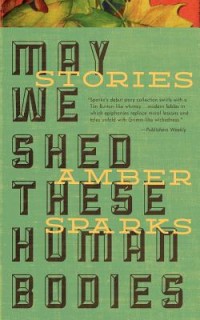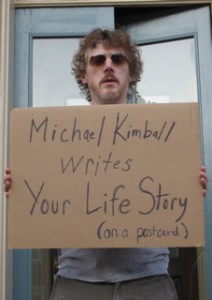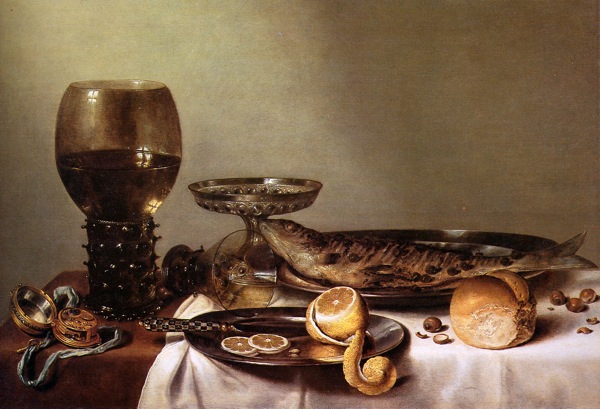25 Points: May We Shed These Human Bodies
 May We Shed These Human Bodies
May We Shed These Human Bodies
by Amber Sparks
Curbside Splendor, 2012
156 pages / $12.00 buy from Curbside Splendor or Amazon
1. Most of the stories in Amber Sparks’ collection, May We Shed These Human Bodies, contain elements of fantasy. This surprised me, because the only other story of hers that I’ve read was straight-up realistic fiction. In fact, pretty much everything I read is straight-up realistic fiction. In the case of Amber Sparks, I humbly make an exception.
2. Sparks does a good job of mixing fantasy and realistic details in the same stories, so they seem to take place in some dream-like space where everything is fucked up and beautiful.
3. One story has a hero who goes on a quest with wizards and swordplay, but during his downtime he smokes cigarettes and daydreams about sports cars. In another story, Peter Pan’s Lost Boys play videogames. And there’s a story about a grim reaper character who wears button-down shirts and chinos.
4. In the Death story, I like how he’s made to seem like an old guy who’s tired of his job, just some loser shuffling around in his bathrobe. And I like how all the humans are unimpressed with him, or by being dead. They call him “The Hall Monitor.” They think the afterlife is “lame.” They are irritated because there are no books.
5. A blurb on the back of the book calls these stories “fables,” but they are not actually talking-animal stories with easily identifiable morals. More often, they are portraits of people in great pain.
6. There is a story about a girl whose boyfriend dies. The story includes these sentences: “… pain is not you, but it is yours, and you cannot return it ever. … it will be with you like an old war wound or scarred-over burn, even when you’ve forgotten what it means or where it came from or who drilled it into your skin, when the first nerve ache began.”
7. There’s a story about Paul Bunyan, and how he’s so big that he accidentally kills people. And he’s gotten old and has arthritis in his wrists and a cramping back. And Babe the Blue Ox has died, so Paul Bunyan is lonely, and he’s been a lumberjack all his life but at last knows the time has come to retire.
8. An aging Third World dictator stays up late at night drinking whiskey and watching Westerns on DVD. Americans sometimes come to visit, but they won’t drink whiskey with him. “The dictator understands that American men no longer have any balls, like when they used to herd cattle and hang men from trees. Now they drink like little girls, with tiny sips, nervousness written all over their milky faces.”
9. Robert Gorham Davis wrote that a story must ask–and answer–a single question: “What is it like to be that kind of person going through that kind of experience?” I think every story in Spark’s collection fits this bill. Every one except “All the Imaginary People are Better at Life.” That one’s just crazy.
10. Just kidding. It’s actually a really cool story. It’s about a girl who cracks up and destroys her relationship with her boyfriend. She speaks to imaginary friends via “space wires.” She tells her imaginary friends her fantasies about running away to Maine and living off of lobsters, but her imaginary friends think she’s crazy. Her imaginary friends are sensible. They offer practical advice. READ MORE >
March 5th, 2013 / 4:45 pm
Hey wow, did my last post, “How To Be A Critic (pt. 6)” just get deleted? Sure looks like it did. Will be curious to hear the reasoning behind that.
This is the first time anything I’ve written for this site has been tampered with.
Announcing The Kmart Belle Lettres Conference: March 6-9
My teddy bear, Kmart, is named after the place where I purchased him: Kmart (specifically, the one on Broadway).
Well, as it so happened, on Friday night, while Kmart and I were eating vanilla cupcakes, reading books about etiquette, and starting our collaborative biography on the Little Mermaid, Kmart turned to me and said (somewhat grouchily, as Kmart is somewhat grouchy): “I want to hold a literary conference!”
“Oh?” I replied.
“Yes,” confirmed Kmart, “and I want it to be right here in New York City. It can be held at Bergdorf’s. It can also be held at McDonald’s. But we won’t need to inform anybody where it’ll be at any given time because only special creatures will be permitted to attend and special creatures are always aware of where special things are.”
“Well,” I said, as I bit into my 27th cupcake, “will there be panels? will there be guests? will there be food? will there be hotel accommodations?”
“Maybe there will be panels, like one panel could be called, ‘Why The Little Mermaid Is More Marvelous Than Everyone.’ But, then again, if I’m feeling grouchy, then there won’t be any panels. And, of course, there will be special guests. Pretty Edna St. Vincent Millay, whom I text with regularly, will come. So will William Carlos Williams, Maya Angelou, Edie Sedgwick, and much more.”
“What about hotel accommodations?”
“The Plaza,” sassed Kmart, “obviously.”
“Sponsors?”
“Duh,” groaned Kmart, “Bambi Muse and Fox News…. Now, let’s return to our Little Mermaid biography. Should we start our author’s preface with a pronoun or an adjective?”
[NB: For complete, comprehensive coverage of the first ever Kmart Belle Lettres Conference read this site – HTML Giant.]
March 4th, 2013 / 5:56 pm
How To Be A Critic (pt. 5)
In part one of this series, I introduced a network of ideas aimed at rethinking our approach to criticism by foregrounding observation over interpretation, and participation over judgment, by asking what a text does rather than what it means.
In part two, I expanded on those ideas.
In part three, A D Jameson unwittingly offered a beautiful example of the erotics I have proposed, following the final imperative of Susan Sontag’s essay “Against Interpretation” — which, for the record is not called “Against A Certain Kind of Interpretation” but is in fact titled “Against Interpretation” — where she writes, “In place of a hermeneutics we need an erotics of art.” To destroy a work of art, as Jameson’s example shows and as Sean Lovelace has shown (1 & 2) and as Rauschenberg showed when he erased De Kooning, certainly counts as an erotics, which for me far surpasses the dullardry of interpretation.
In part four, A D Jameson unfortunately embarrasses himself by indulging his obvious obsession with this series. Whereas one self-appointed guest post might seem clever or even naughtily apropos, two self-appointed guest posts (in addition to all of his contributions in the comment sections) conjures the image of a petulant child acting out in hopes of garnering his father’s attention. (Daddy sees you, Adam. He’s just busy doing work right now.) Yet, despite his cringe-worthy infatuation, the example he offers is an effective one. I applaud it. (As Whitman said, “Do I contradict myself? / Very well then I contradict myself, / I am large, I contain multitudes.”)
This time, I’ll do a little recapitulation, elaboration, and I’ll introduce other lines of flight. But first, an important note about the necessity of revaluation. (Following Nietzsche’s project, of course. Itself predicated on Emersonian antifoundationalism, of course.)
Chateau Wichman IV and V by Ben Pease
Here are the latest installments of Ben Pease’s epic video poem, Chataeu Wichman. Previous installments in the series can be found below.
ON CARDBOARD: Michael Kimball
Michael Kimball still feels like a bit of a sleeper hit. It’s not as if people aren’t reading him, or discussing him, or heeding his presence in general on earth; but when you yourself pick him up and feel the various array of facial slaps he harbors in his repertoire, you can’t help but think his work’s been waiting around for you to discover and devour it.

@MichaelKimball
Kimball’s already been discussed, reviewed, and interviewed in and around the online literature sphere, so that’s not what this will be. No. This is the result of one day having opened in congruence Kimball’s Twitter page, and a page of blurbs re: Big Ray. His Twitter avatar is a picture of him holding a cardboard sign that reads MICHAEL KIMBALL WRITES YOUR LIFE STORY (ON A POSTCARD) in promotion of a series of posts on Kimball’s blog where he writes the stories of various writer’s/friend’s in the space allotted by a postcard. The juxtaposition of this and the reviews of Big Ray made me realize: I want to review books on slabs of cardboard exactly like that, but weirder, maybe.
I tweeted to Kimball about the possibility (see below) and, solid dude that he is, he obliged. What follows are those reviews.

There will be two reviews, essentially; the first being a photograph of a large readable-from-a-distance review of the book without any corresponding text below. The second will be a smaller-but-still-fairly-large review of the book on the back of said cardboard with the text transcribed below.
Why the hell am I doing this? I guess from the get go I was never going to write normal reviews of anything. I’m terrible with journalism and essays have always eluded me. At best I can write a decent rant about shit I love, and this seemed an original way to describe art that I’m fond of while not getting too far outside the realm of reason.
March 4th, 2013 / 12:00 pm
Dance Around Like Meth Monkeys: A First Date Interview With Rauan Klassnik
Favorite color:
You have such gorgeous eyes!
Favorite food:
And such a brawny chest! And such expensive furnishings!
Favorite restaurant (besides Applebees):
Yeah, I admit it, I dated Adam for a while, but he was just way too demanding, physically, I mean. Always wanting me to act my book out on him. Really it was just too exhausting.
Favorite movie:
Do you live close by??
Favorite place in the world:
How much does your mother weigh? READ MORE >
Lovely argument

“That’s what Mommy made for dinner,” the woman behind me said. The museum was crowded the way Sundays are. Like grocery stores and churches, we apprehensively prepare for the week and the rest of our lives, respectively. I would have ridiculed her — for her provincial and self-involved inclinations towards great art — but found it, now at this point in my life, very touching. A dollop of love hardened in my throat for this dumb person. She held her daughter against her side, the latter who even grazed my ear pointing at the painting the way children always point at referents, as if to convince the world there’s only one thing, to consolidate life’s erratic foci into a single point. “Our fish didn’t look like that!” the daughter said. “Okay but the lemon did.”
How To Be A Critic (pt. 4)
Resist making value judgments.



